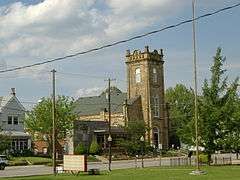East Spring Street Historic District
|
East Spring Street Historic District | |
|
First Baptist Church | |
  | |
| Location | Roughly bounded by E. 5th, E. Spring, E. 8th, and E. Market Sts., New Albany, Indiana |
|---|---|
| Coordinates | 38°17′18″N 85°48′57″W / 38.28833°N 85.81583°WCoordinates: 38°17′18″N 85°48′57″W / 38.28833°N 85.81583°W |
| Area | 32 acres (13 ha) |
| Architect | Riedinger, Ludwig |
| Architectural style | Queen Anne, Italianate, et al. |
| NRHP Reference # | 02001566[1] |
| Added to NRHP | December 19, 2002 |
The East Spring Street Historic District is a national historic district located at New Albany, Indiana. The general area is E. Fifth Street to the west, Spring St. to the north, E. Eighth Street to the east, and Market Street to the south. The Cedar Bough Place Historic District is one block north of the area, the New Albany Downtown Historic District is immediately west of the area, and the Market Street section of the Mansion Row Historic District starts. The district encompasses 84 contributing buildings in a largely residential section of New Albany. It developed in the late-19th and early-20th century and includes notable examples of Queen Anne and Italianate style architecture. Notable buildings include the Third Presbyterian Church (now First Baptist Church, 1853, 1955), St. Mary's Roman Catholic Church and Rectory (1858, 1886), the former John Conner House or Masonic Lodge (c. 1850), and Edwards City Hospital (c. 1890).[2]
It was listed on the National Register of Historic Places in 2001.[1]
In its prime, it was a haven for those of middle-class and upper-class social status. Many churches are within the area.
Gallery
-

Colonial Revival home
-

Queen-Anne home
-

New Albany Masonic Temple
References
- 1 2 National Park Service (2010-07-09). "National Register Information System". National Register of Historic Places. National Park Service.
- ↑ "Indiana State Historic Architectural and Archaeological Research Database (SHAARD)" (Searchable database). Department of Natural Resources, Division of Historic Preservation and Archaeology. Retrieved 2015-10-01. Note: This includes Camille Fife and John Warner (May 2002). "National Register of Historic Places Inventory Nomination Form: DePauw Avenue Historic District" (PDF). Retrieved 2015-10-01. and Accompanying photographs.


